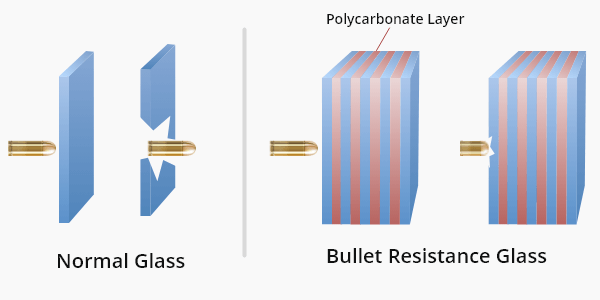Bulletproof glass, also known as ballistic glass or bullet-resistant glass, is a specialized material designed to withstand the impact of bullets or other projectiles, providing protection against ballistic threats.
This advanced material is a result of innovative engineering and combines various elements to create a strong and resilient barrier.
Composition:
- Layers of Glass: The primary component of bulletproof glass is multiple layers of glass laminated together. These layers can vary in thickness and composition, often combining different types of glass to enhance strength.
- Polycarbonate or Acrylic Interlayers: Sandwiched between the layers of glass are tough, transparent plastic interlayers, typically made of polycarbonate or acrylic. These interlayers play a crucial role in absorbing and dispersing the impact energy of a projectile.
Construction Process:
- Layering and Lamination: Bulletproof glass is created by sandwiching multiple layers of glass with the plastic interlayers. These layers are then subjected to high pressure and heat, fusing them together through a process known as lamination.
- Varied Thickness and Combinations: Manufacturers can customize the thickness and composition of bulletproof glass based on the level of protection required. Thicker glass and additional layers of interlaminated materials enhance the resistance against different calibers and velocities of projectiles.
Levels of Protection:
- Bullet Resistance Levels: bullet proof car glass is categorized into different levels, such as Levels 1 through 8, based on its ability to withstand various ballistic threats. These levels are determined by testing against specific bullet calibers and velocities.
- Resistance against Other Threats: In addition to bullets, bulletproof glass can also be engineered to resist impacts from explosives, blunt objects, or even extreme weather conditions.
Applications:
- Security and Military Uses: Bulletproof glass is extensively used in military vehicles, armored cars, and buildings to protect against potential attacks and provide security in high-risk areas.
- Commercial and Civilian Applications: Banks, government buildings, VIP Armored vehicle, storefronts, and even residential properties may utilize bulletproof glass for enhanced security and protection.
Limitations:
While bulletproof glass offers significant protection, it’s essential to note that no material is entirely “bulletproof.” The effectiveness of bulletproof glass depends on factors like the caliber and velocity of the projectile, as well as the design and construction of the glass.
Conclusion
Bulletproof glass stands as a testament to the ingenuity of material science and engineering. Its unique composition, armored1 combining layers of glass and interlaminated plastics, forms a robust barrier capable of withstanding ballistic threats. From military applications to civilian security needs, bulletproof glass continues to play a pivotal role in providing enhanced protection in a variety of scenarios.
As technology advances, ongoing research and development aim to improve the effectiveness and versatility of bulletproof glass, ensuring its continued use in safeguarding lives and property in an unpredictable world.
You Might Also Like: IS A DODGE CHARGER A LUXURY CAR?

